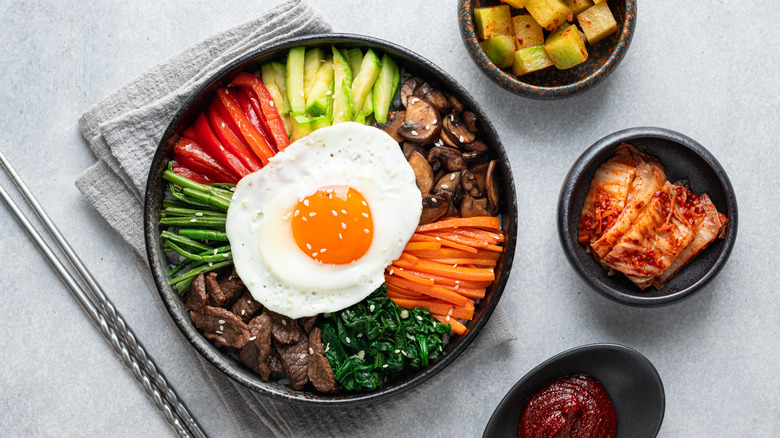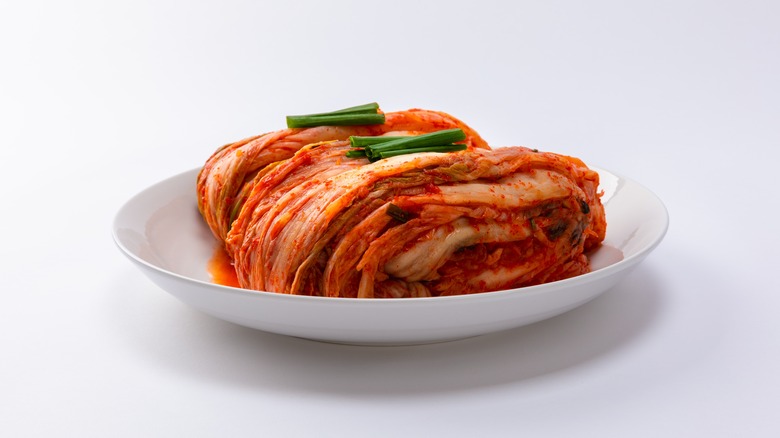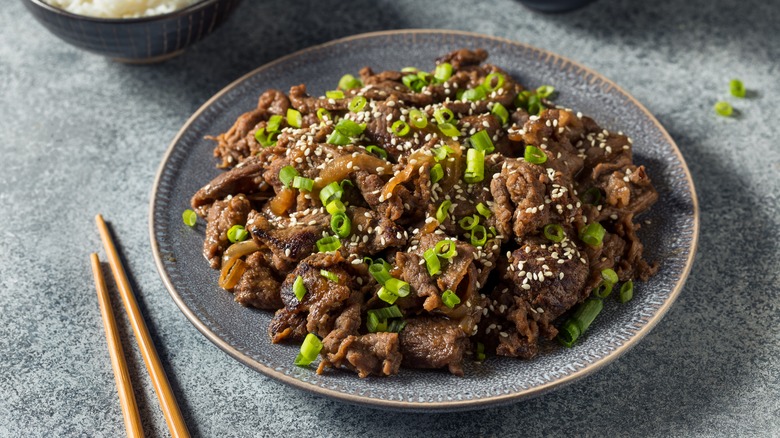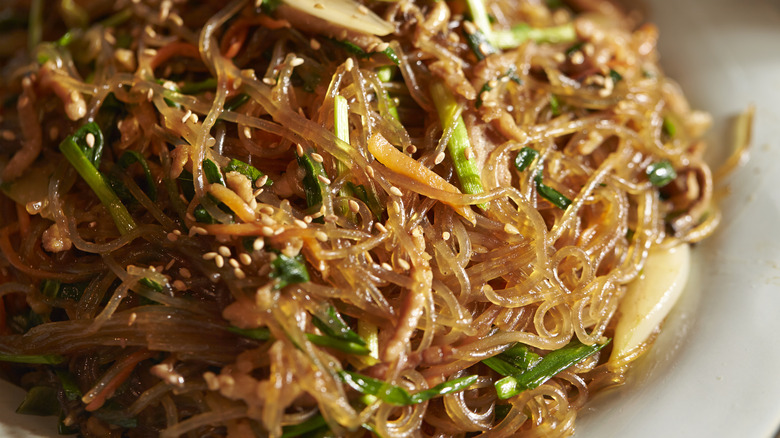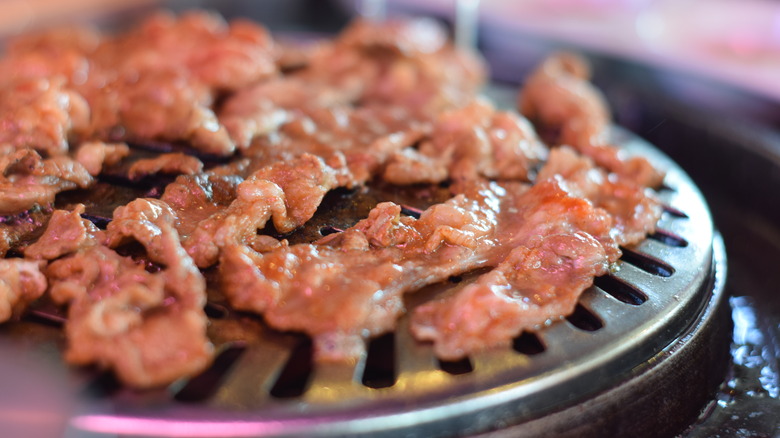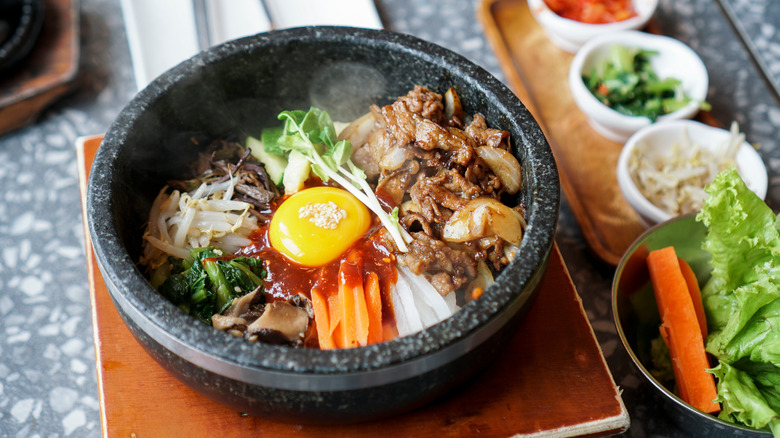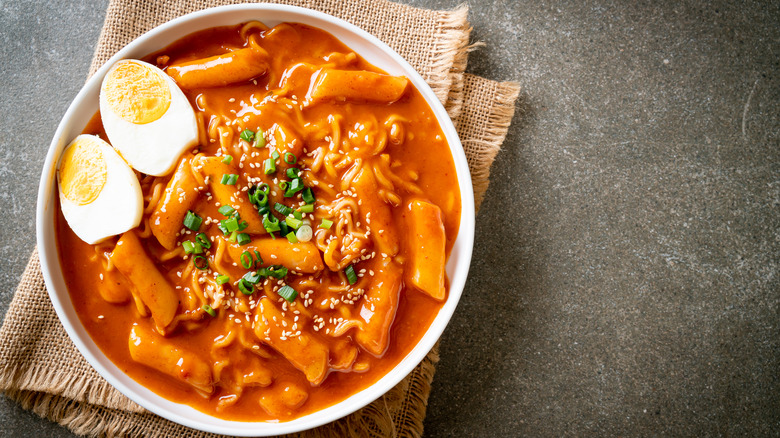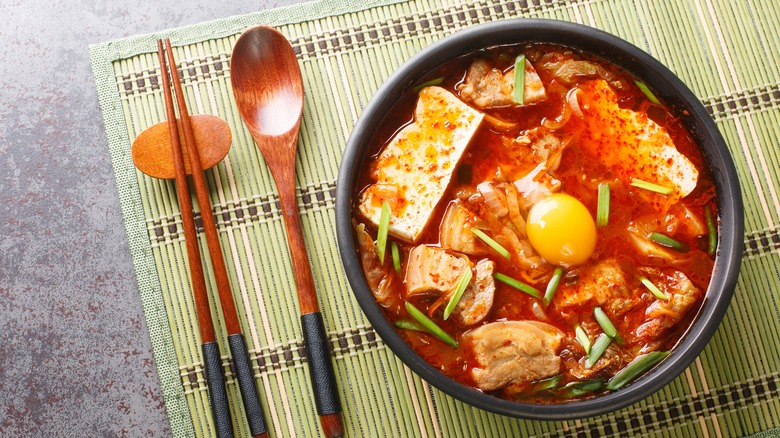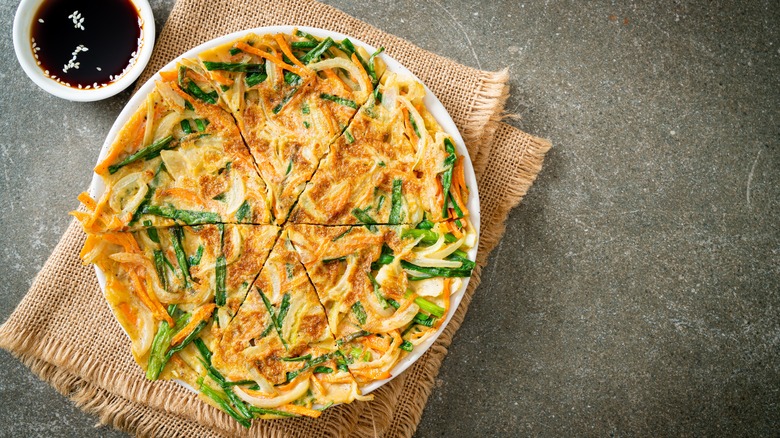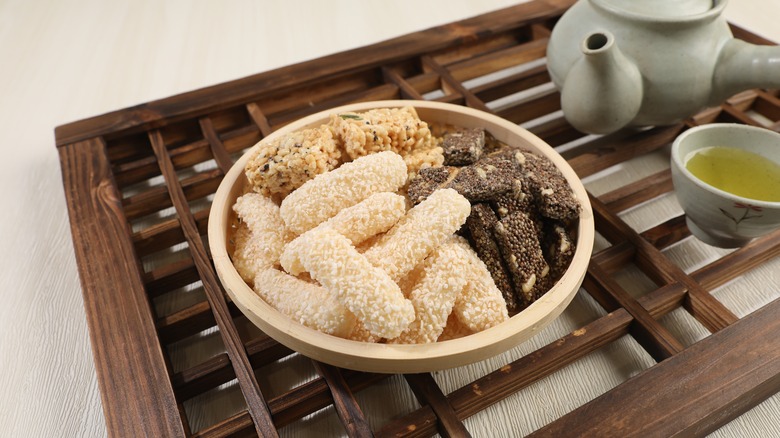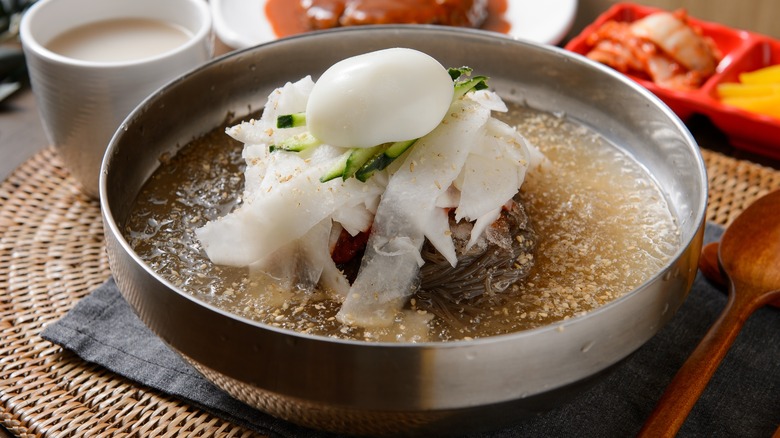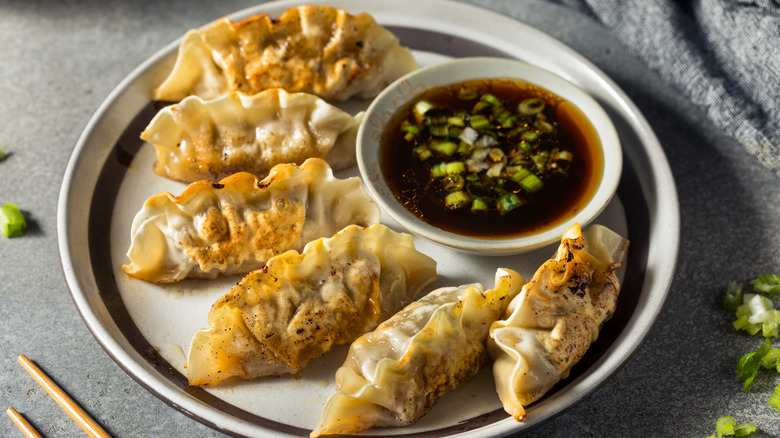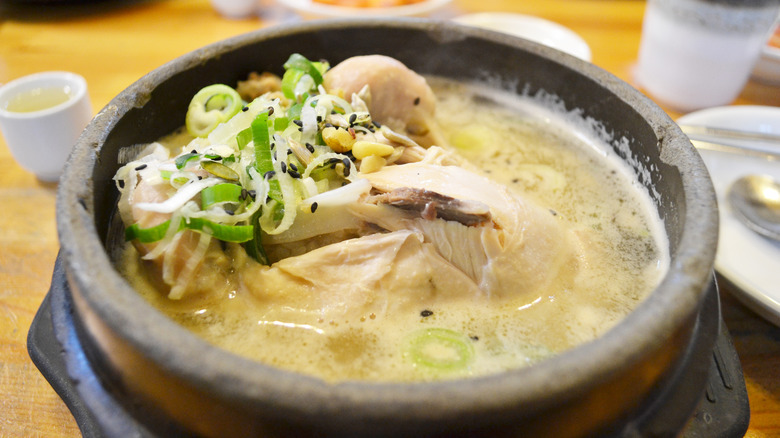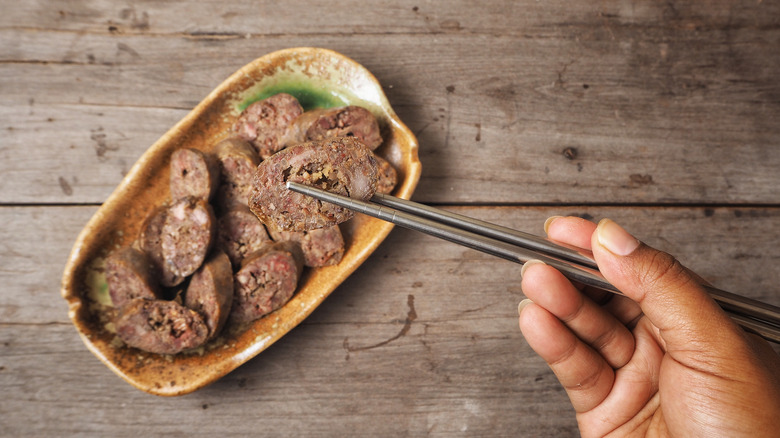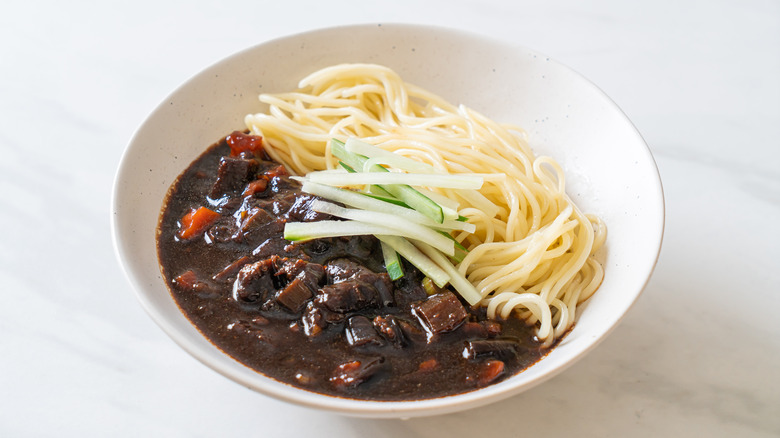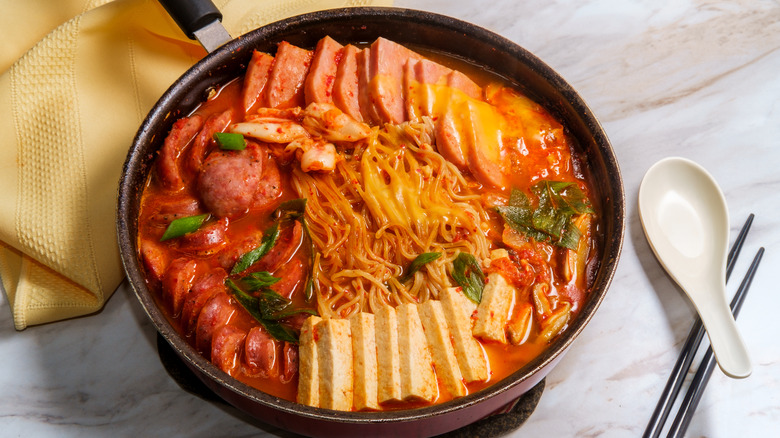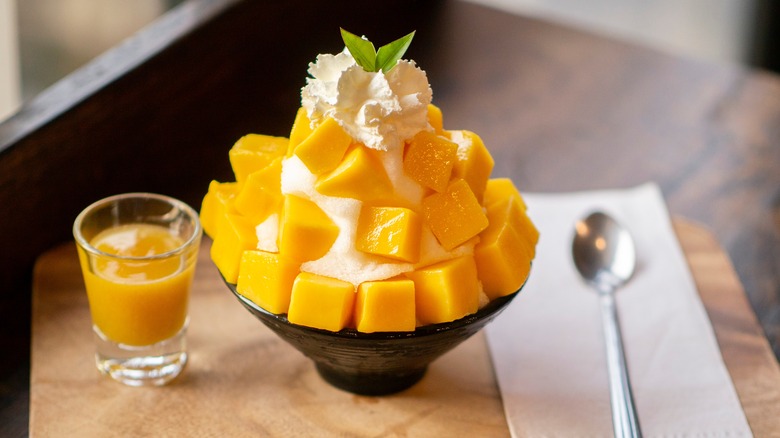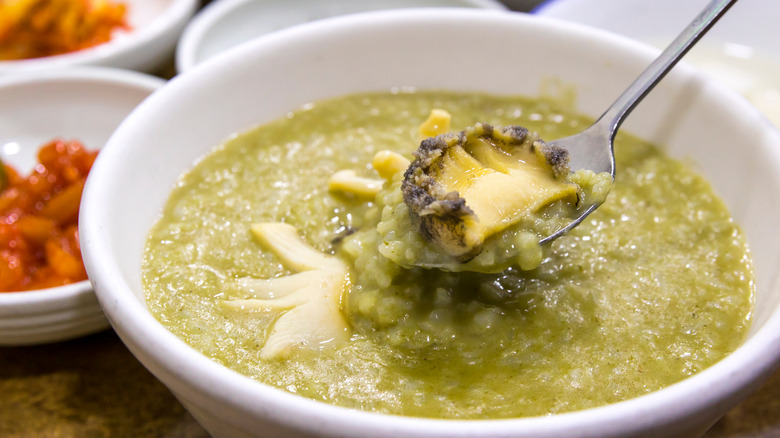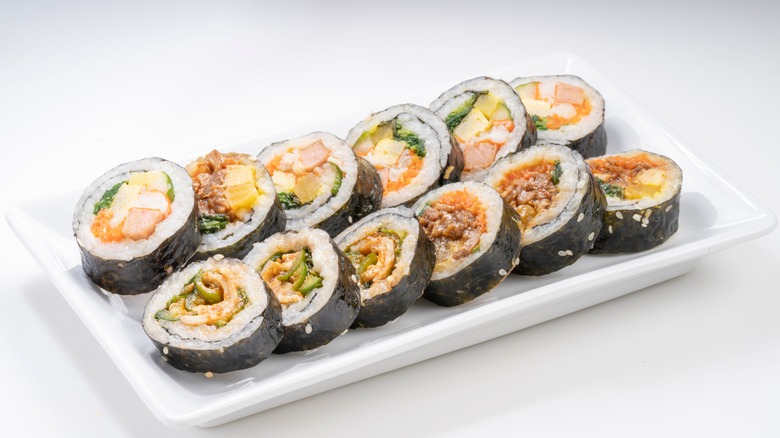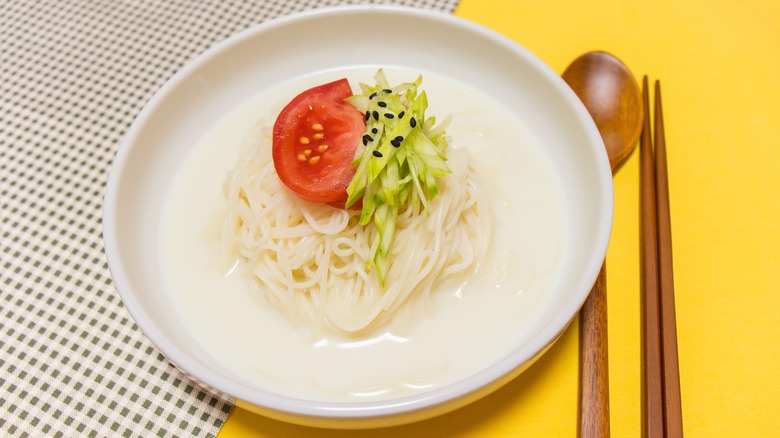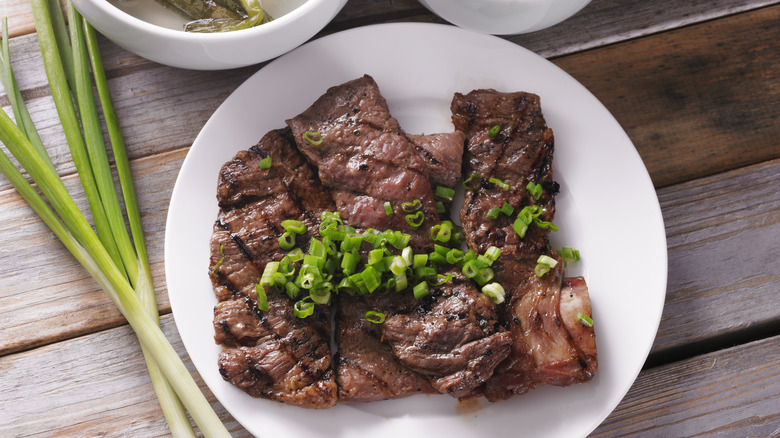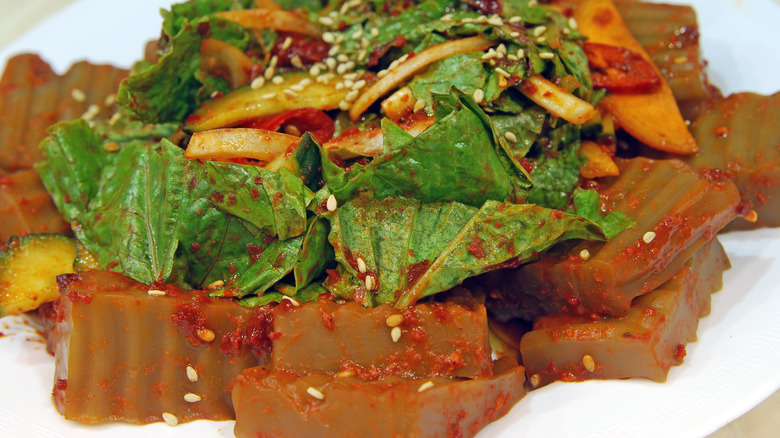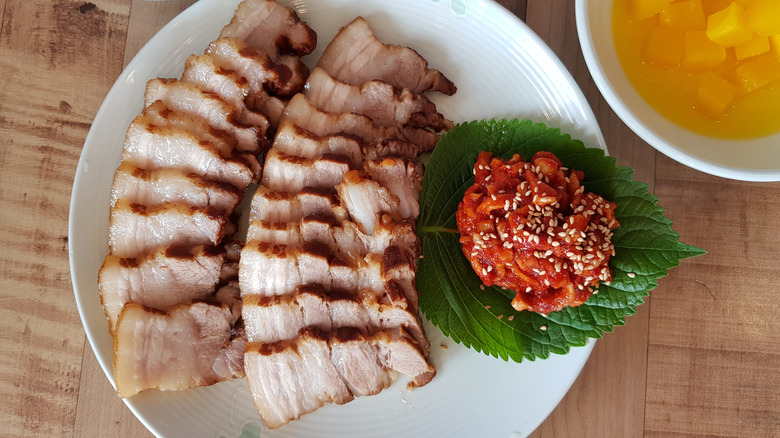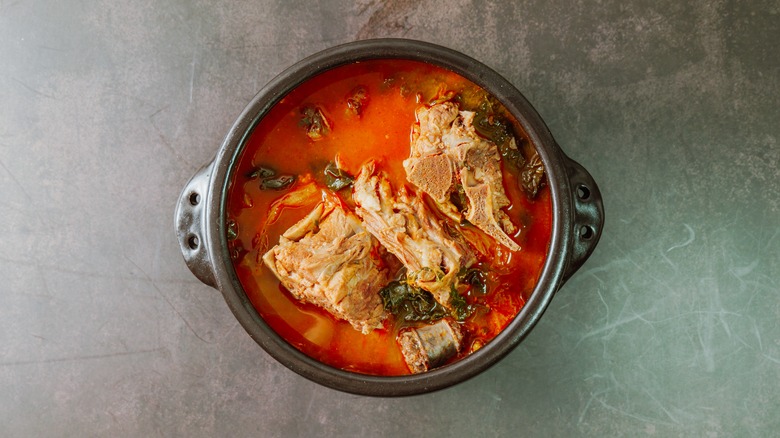25 Traditional Korean Dishes That You Need To Try At Least Once
There's a lot to love about Korean food. The menu of the Korean peninsula has maintained its emphasis on fresh, nourishing cuisine — that's also heavily influenced by geography and tradition – into the modern day. In Korean culture, food is valued as much for its benefits as it is for its flavor, and the preparation of food is often a labor of love and time. This has led to a food culture that's distinct from any other, and it values preparation methods like fermentation heavily.
As the modern world developed, Korean food has become ever more popular across the globe. "Korean food is already popular, but thanks to recent pop culture influences there's going to be a lot more focus on, and demand, for authentic food and flavors from [that region]," research analyst Ranjana Sundaresan told The Food Institute. The rise of K-pop and K-dramas becoming widely consumed has led more people to investigate Korea's food culture and fall in love with it.
But while most people may have tried kimchi and bibimbap by this point, that's just the tip of the iceberg. Korea's traditional cuisine is diverse, rich, and exciting. There are many dishes, including ones that you likely haven't tried, which combine flavors and textures in innovative and delicious ways. We've compiled a list of all our favorites right here.
1. Kimchi
How could a list of Korean food not include kimchi? The quintessential Korean dish has truly ancient roots, having first been developed approximately 4,000 years ago.
Kimchi has stood the test of time thanks to its unique preparation style, which traditionally involves fermenting cabbage or other vegetables in a spicy seasoning paste in a clay vessel known as an onggi. This fermentation process preserves the vegetables, extending them far beyond their lifespan, which allows them to stay edible in the days of no refrigeration.
This food is a banchan, one of many side dishes that make up a complete meal in Korean cuisine. While kimchi in the West is commonly made from cabbage — along with a tart, bright-red sauce — the truth is that kimchi can be made from pretty much any vegetable you choose. In Korea, kimchi is eaten at pretty much every meal and is totally irreplaceable.
2. Bulgogi
Bulgogi is one of the most popular Korean dishes out there and has become somewhat of a symbol of Korean cuisine around the globe. It's also been around for a while. Bulgogi — which translates to "fire meat," indicating how it is cooked — has existed in various forms for thousands of years. Marinated, roasted meat has been a fixture in traditional Korean menus since as far back as the Goguryeo dynasty (which ended in the 7th century) when marinated roasted meat would be cooked over a fire, on a skewer.
Today, bulgogi still follows these cooking traditions and is most commonly cooked on a barbecue or griddle. When made at home, it's also cooked more simply, in a skillet on the stove. The meat (usually beef, although pork and chicken are also used) is marinated with the classic Korean flavors of soy, sesame, sugar, and garlic, cooked, and then served with rice or in soup.
3. Japchae
Japchae is a food with a royal lineage. The noodle dish was originally conceived for a celebration hosted by King Gwanghaegun, the leader of the Chosun dynasty, hundreds of years ago. The king was so pleased with the dish that it quickly became a staple on royal menus.
This dish has retained its association with special occasions and is commonly made to be served as part of wedding banquets. The food is a seemingly simple mixture of vegetables, beef, and noodles, flavored with soy, sugar, and sesame oil. Rather than being cooked together, the ingredients for japchae are stir-fried separately, before being mixed and then served.
Japchae is set apart from other noodle dishes by its use of sweet potato noodles. These noodles have a see-through consistency that makes the dish glossy and special-looking, and a pleasing chewy texture.
4. Samgyeopsal
Korean cuisine commonly employs the power of a barbecue to develop deep, caramelized flavors in meat dishes. Samgyeopsal is a great example of this.
This dish is relatively simple in its bare bones, and in its most rudimentary form is simply grilled pork belly, cooked on a high heat to develop a brown, crispy exterior. Where it really shines, however, is in its serving style. Samgyeopsal is commonly eaten with ssamjang, a spicy, funky dipping sauce, and other grilled vegetables wrapped in a lettuce leaf to make a perfect, delicious bite of food.
Samgyeopsal differs from bulgogi due to its lack of marination: Whereas bulgogi is soaked in soy and sesame before cooking, samgyeopsal is cooked with minimal preparation. The dish gained wider popularity in the 1980s when a beef shortage caused Koreans to have to consider other meat sources, and pork and chicken became more widely eaten.
5. Bibimbap
Bibimbap is a well-loved dish, and its name is as pleasing as its flavor. The word "bibimbap" directly refers to how the food should be eaten, with "bibim" translating to "mixing" and "bap" meaning "rice." Upon receiving a bowl of bibimbap, the different elements are mixed, creating a bowl of intense flavors and pleasantly contrasting textures.
Bibimbap has been a staple dish in Korea for centuries, but, like many Korean foods, it has achieved wider prominence more recently. Bibimbap's popularity can be partly attributed to its being served on Korean Air flights in the 1990s, introducing more people to its unique pleasures.
While bibimbap is simple, its joy is in the combination of separately cooked vegetables and portions of meat, with each of them contributing its own flavor profile. It's commonly served with a hot fermented sauce, which ties the flavors together and turns the rice a bright red.
6. Tteokbokki
If you've watched a K-drama or spent much time on the food side of TikTok — otherwise known as "FoodTok" — you've probably seen tteokbokki. This Korean street food is taking over the food scene, as much for its taste as for its unique composition.
Tteokbokki is a rice cake dish, with distinctively shaped cylindrical rice cakes simmered in a sweet, spicy sauce flavored with anchovies and gochugaru. When simmered, the cakes soften considerably and develop a chewy, almost taffy-like consistency, while the sauce stops the dish from becoming too cloying.
This is traditionally a grab-and-go food, with tteokbokki stalls being a common feature at Korean food markets or in districts where there are a lot of bars. It's also a common convenience food, coming in ramen-style cup packets. Tteokbokki is commonly served on its own, but is also frequently adorned with proteins like fish cakes or boiled eggs, or bulked up with the addition of instant ramen or vegetables.
7. Sundubu jjigae
Stews (or jjigae) are common in Korea, and there are many variations that champion different flavors. In sundubu jjigae, though, it's all about the gochujang. The fermented red chili paste features heavily in sundubu jjigae, and infuses it with a huge amount of flavors, with sweetness, spiciness, and saltiness all provided by the ingredient.
Sundubu jjigae is also full of extra-soft tofu (with the "sundubu" in its name referring to this), which has a mild, nutty flavor that counteracts the fierce spice that the gochujang provides. Beyond these two ingredients, sundubu jjigae can contain pretty much anything. Some chefs prefer to focus heavily on seafood in their stews, filling the dish with shrimp, mussels, and clams, whereas others keep them vegetarian. The dish tends to be served simply, usually directly from the pot it's cooked in, and is usually paired with steamed white rice and additional banchan.
8. Pajeon
Pancakes are a feature of many national cuisines around the world, and in Korea, things are no different. In Korean food, however, savory pancakes tend to take center stage, with pajeon being a common appetizer or bar snack.
Pajeon, when translated, literally means "green onion pancake," and that gives a clue to the main ingredient. The dish is usually made up of sliced green onions that are bound together with a simple flour and egg batter, which is then poured into a pan and cooked until crisp on each side.
While green onions feature heavily, pajeon can also contain an abundance of other vegetables or meats. Some variations, like kimchi pajeon, rely more heavily on one ingredient to provide flavor. Pajeon was originally developed as a way to create a substantial meal from cheap yet filling ingredients, but it's also a dish commonly served around festivities and national holidays.
9. Gangjeong
Korean sweets are totally delectable, and gangjeong might be the best of them all. This hangwa (the name for a traditional Korean candy) is made by deep-frying glutinous rice flour until it develops a crispy consistency, and then coating it with a sweet coating and other additions. Sesame seeds and chopped nuts are often used to cover the rice puff, and they can also be brightened up with food colorings, to give them visual flair.
Elsewhere, the term gangjeong can be used in the description of other candies. Yeot-gangjeong, for example, is a confection that's similar to peanut brittle. It's made by combining nuts like pistachios and cashews with a thick rice syrup. When the syrup cools, the whole thing adheres together, making a solid block that can then be sliced into smaller pieces. The candy pieces are then wrapped individually, and given out as small treats.
10. Naengmyeon
Naengmyeon is a treat for the senses. This totally unique noodle dish is defined by its icy cold broth, into which cold noodles are mixed and various additions like sliced meat and vegetables are added. Naengmyeon is commonly served in the summer months, when the noodles have a cooling effect. But they can also be eaten in the depths of winter, and certain variations, like spicy Hamhung naengmyeon, are eaten to give the body some heat.
Pyongyang naengmyeon is a particularly well-known version of naengmyeon. As its name indicates, this dish was originally conceived in the North Korean capital. Pyongyang naengmyeon uses buckwheat noodles (which are commonly made by hand and using a noodle press) bathed in a semi-clear beef broth, with fermented vegetables and proteins, usually sliced beef, also included. Although this type of naengmyeon started in North Korea, it can also be found in South Korea.
11. Mandu
A large number of cuisines in Asian countries have their own form of dumpling. Korea, too, has a distinctive version that's endlessly delicious, and enjoyable to make.
Mandu is, upon first glance, pretty similar-looking to jiaozi or gyoza, often coming in a half-moon shape. Like other dumplings, though, they can be folded in many different ways, and mandu have a huge variety of fillings that set them apart from others. Pyeonsu, for example, is a mandu folded into a unique pyramid shape with a square base, and filled with vegetables like zucchini or beansprouts.
This dish is, like a few other things in Korean food culture, a food that started as a royal delicacy and has become commonplace. These days, mandu are eaten everywhere, but are also a key item around Lunar New Year celebrations, thanks to their association with luck. Around this time, making them becomes a family affair.
12. Samgyetang
Ginseng has a firm place in traditional Korean culture and has been associated throughout the years with miracles and gods, as well as being used widely in ancient medicine. It's little wonder that samgyetang, or ginseng chicken soup, is as well-regarded as it is.
Samgyetang is a dish that's been around since the 1500s when ginseng was commonly used in cooking. The recipe, and its potential health benefits such as providing energy and strengthening the immune system, have been passed down throughout the ages, and it remains widely consumed today.
To make samgyetang, a small whole chicken is placed in a pot, after being stuffed with glutinous rice and ginseng. The chicken is then covered in water flavored with ginseng, garlic, and jujubes, and simmered until everything's cooked. The chicken and broth are then ladled into a bowl, and served topped with chopped green onions.
13. Soondae
If you want something completely unique, try soondae. This foodstuff is less well-known outside of Korea, but in the country, it remains both a delicacy and a popular street snack.
Soondae is a blood sausage, made by stuffing cow or pig's intestines with a combination of pig's blood, noodles, and sometimes rice. Various seasonings and spices are also mixed into the combination, and then the end result is steamed, before being sliced and served in portions.
When cooked, soondae has a particularly chewy consistency, thanks to the inclusion of noodles or rice. The sausage has an especially ancient history, appearing in its first forms in the Goryeo period between the 10th and 14th centuries, before having a resurgence in popularity following the Korean War. As well as being eaten on its own or alongside other street food staples, soondae can also be used as an ingredient in stir-fries.
14. Jajangmyeon
Jajangmyeon might be one of the most recognizable Korean dishes outside of the country itself, thanks to it appearing regularly in Korean films and TV shows. The reason why it shows up so much, however, is because it's delicious.
This dish is a great example of Chinese cuisine's influence in the country, with the dish originally developed by Chinese immigrants, who arrived in the Incheon area around the 20th century. The dish is inspired by zhajiangmian, a similarly saucy Chinese dish that contains many of the same ingredients.
Jajangmyeon is made by frying Chunjang, a dense, black paste made from fermented wheat flour. The paste is then seasoned and various ingredients are added to it, including meat and cubed vegetables, which give it body. The sauce is served next to, or on top of, thick wheat noodles, with everything mixed together. It has a savory, sweet, and slightly funky flavor.
15. Budae jjigae
One of many different jjigae varieties, budae jjigae speaks to Korea's recent history and some of the consequences of its military action. Budae jjigae translates to "army base stew," with its typical American ingredients indicating somewhat how this meal came into being. The Korean War caused a great deal of food shortages across the country, and as a result, food available from American army bases near Seoul started to make its way into Korean cuisine. This food, like Spam and hot dogs, had a long shelf life thanks to being processed, and Koreans would cook with the leftovers.
Thus, budae jjigae was born. The stew is a combination of processed meats, rice cakes, ramen noodles, and kimchi, all simmered together until cooked through. It's frequently cooked in large portions and served communally. A comfort food, budae jjigae is often also eaten alongside alcohol.
16. Gopchang
Korean food is especially notable for its resourcefulness and resistance to food waste. Nowhere is this as clear as with gopchang. Gopchang is the small intestines of an animal whose meat is usually used for cooking, like beef or pork. The intestines are usually sliced into small pieces and when cooked, have a chewy consistency.
Gopchang has been eaten in the country for hundreds of years and was traditionally seen as a pricey delicacy. It was also eaten for its restorative properties, being abundant in minerals like iron. Gopchang is also prized for its versatility and is eaten in numerous ways. Arguably the most well-known of these is gopchang-gui, with the intestines grilled and served with other meats or fried onions. This is a popular meal to be eaten while drinking soju, with the richness of the meat helping to counteract the alcohol and stop people from getting too drunk.
17. Bingsu
Sometimes, the most simple foods are the best. Bingsu is the Korean form of a snow cone and is a common cold treat during the summer months. Bingsu is distinguished from other shaved ice-based desserts by the presence of red bean paste, which is usually used as a topping. This version, known as pat-bingsu, also frequently uses condensed milk to sweeten the ice.
Other bingsu forms are slightly more elaborate, with jellies, mochi pieces, and sweetened fruits also layered over the ice, making a form of sundae. The ice can also be flavored with a variety of different ingredients to give the bingsu an ice cream-like quality, with tastes like green tea and mango infused into the dessert. Bingsu is usually served in a small, circular bowl, as opposed to a cone, with the bowl shape helping to catch any toppings that drop off the top of the ice.
18. Juk
Every cuisine has foods that nurture and revive, and in Korean food, juk is as restorative (and as simple) as it gets. Juk is Korean rice porridge, and it's made by extending the cooking time of rice and adding more water, so it breaks down further. Similar to congee, juk is rich in carbohydrates and is very easy to digest. As such, it is commonly served to those battling sickness or digestive issues.
Juk can be eaten any time of the day, but it's most frequently eaten at breakfast. It often has pine nuts or abalone stirred into it, but it can also serve as the base for a million different flavors. It's fairly common to find juk with mushrooms, vegetables, seafood, or eggs topping it. Juk is also a great meal to eat during the winter months, as it's both comforting and warming.
19. Kimbap
It's understandable to confuse kimbap with sushi, but these rice rolls are in a league of their own. Kimbap is similar in construction to sushi rolls and is made by wrapping seasoned rice and fillings inside a seaweed wrap and then slicing it into rounds. The flavors and fillings, however, are unmistakably Korean.
Whereas Japanese sushi generally keeps its flavors fairly neutral, Korean kimbap goes for big blows taste-wise. Sharp pickled radish and tangy fish cakes are often wrapped in the rice, which can be scented with sesame oil. Deep-flavored savory beef can also be used as a filling.
Kimbap also tends to be slightly wider than sushi, with a higher ratio of fillings to rice. While kimbap is usually served straight after being sliced, it can also be pan-fried after being covered in egg, to add protein and texture and make it more filling.
20. Kongguksu
Korean cuisine is excellent at matching texture and temperature with the surrounding seasons, to create food that serves a function as well as tasting good. Kongguksu is a prime example of this. Kongguksu is a cold noodle soup with a broth made from soy milk, which often has ice cubes added to it just before serving. The dish strives to remain simple, sticking to just the noodles and broth, and potentially a few cooling toppings like fresh cucumber or tomatoes.
The chilling effect the meal has is perfect for a hot Korean summer day and the humidity that can come with it. The broth also provides the diner with important hydration. Kongguksu is also appealing as it's incredibly easy to make, even if you're making your own soy milk at home. Its vegan nature also makes it accessible for people who follow a plant-based diet.
21. Galbi
Galbi is one of the most comforting Korean foods there is. Translating to "rib" in English, galbi is pretty much just that: A dish of ribs, marinated in a combination of soy sauce, sugar, garlic, sesame oil, and rice wine, and then grilled. Beef or pork ribs are generally used to make galbi, with the high-fat content of the short ribs giving the dish richness and succulence.
Galbi is usually served with a classic Korean barbecue set-up, which sees it eaten accompanied by lettuce wraps, rice, and ssamjang. The latter is a dipping sauce made from fermented soybean paste and chopped onions and garlic, giving it a punchy, savory-sour flavor that accompanies the mellowness of the galbi perfectly. Galbi can also be followed by a bowl of naengmyeon, with the cold noodles serving to cleanse the palette and offer a contrast to the hot meat and spicy sauce.
22. Dotorimuk
Dotorimuk is one of the most distinctive Korean dishes there is. The dish is an acorn-flavored jelly, and today is usually made by preparing acorn starch bought from the store. The acorns in the dish give the jelly a deep brown color and a nutty, slightly bitter flavor, with the consistency of the jelly being slightly firmer than what you might expect from Jell-O.
Unlike Jell-O, too, dotorimuk is not served sweet. Instead, it's usually combined with savory flavors, and dressed with soy sauce, chili, and green onions. Vegetables like carrots or cucumber can also be stirred through with the seasoning sauce. This dish, known as dotorimuk-muchim, is a banchan and is served alongside a host of other small side dishes as part of a main meal. While it's possible to make dotorimuk from scratch, processing the acorns to be edible takes a lot of work.
23. Bossam
In Korea, meat dishes are often prepared through grilling, roasting, or frying. But bossam takes a different approach: the meat is boiled. Bossam is a simple dish of boneless pork belly, which is boiled slowly in a broth that includes garlic, scallions, onions, ginger, and peppercorns. Once the pork belly is cooked, it's then sliced, and served in a classic Korean style, with the meat wrapped in a leafy vegetable like napa cabbage or lettuce.
Bossam is a food that's born of function and was originally prepared around the gimjang period, the time when kimchi preparation began for the winter months. To keep everyone fed, bossam would be made, with the pork slices being eaten with the napa cabbage leaves that would make the kimchi. The broth that the bossam is cooked in infuses the pork with added flavor and does so without marinating it.
24. Gamjatang
Gamjatang is a dish with a functional history. The stew, like many stews around the world, was championed by laborers who needed a filling, easy meal when the working day was done. In gamjatang's case, it was Incheon dock workers who led to the dish becoming so popular, with the combination of meat and potatoes serving to keep people satisfied without being too pricey.
Gamjatang is usually made with pig neck or spine bones, simmered with sliced potatoes and aromatics like garlic and onions. When the bones are boiled, the pieces of meat left on them are released into the broth, giving it a rich savory flavor. The dish has remained a workers' staple and is often eaten during a drinking session or as a hangover cure. When combined with rice and kimchi, it delivers a full, filling meal, with ample amounts of flavor.
25. Dasik
Dasik are a treat for the eyes, as well as the stomach. These delicacies are small cookies made with a honey-infused dough that's made from grain and rice flour, which is then pressed into specially carved molds. These molds contain intricate designs that give the top of each cookie a beautiful, distinctive pattern. Dasik can also be luminously-covered, in shades of bright pink or green.
Dasik are traditionally eaten with tea and have a longstanding ceremonial and cultural function. In ancient royal settings, the patterns that each dasik was pressed with would signify a desired quality, like wealth or health. Dasik are traditionally pressed using a wooden device called a dasikpan, which has patterns embossed into the top half, and a container in the bottom half to place the dough. Unlike regular cookies, dasik aren't baked, and once pressed are ready to be eaten instantly.
